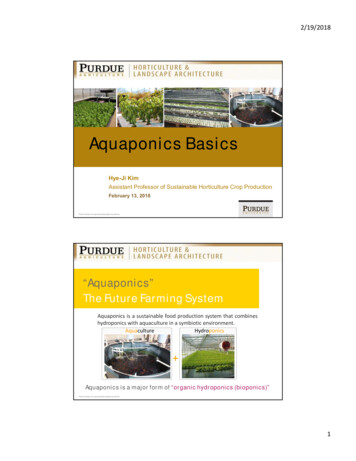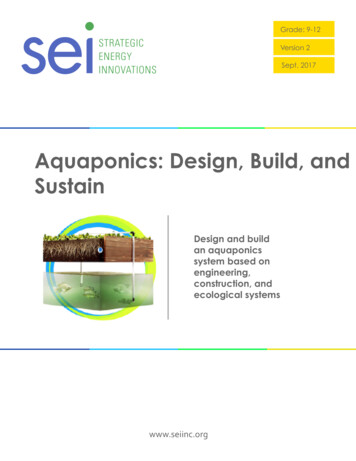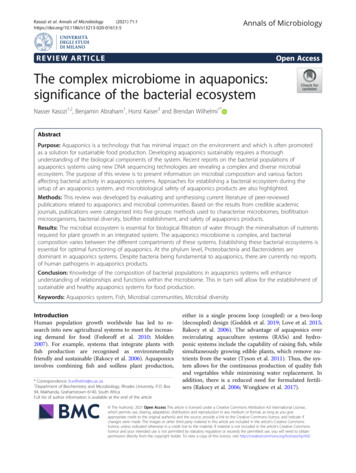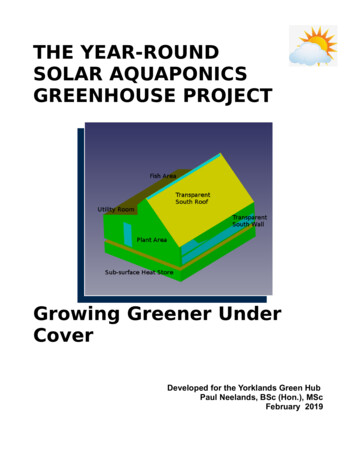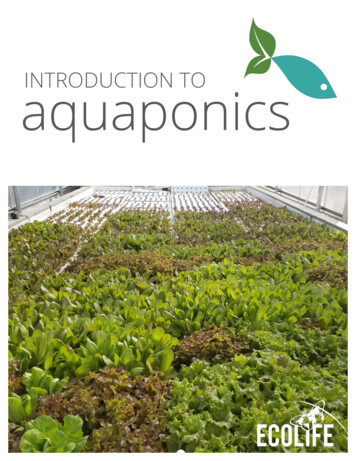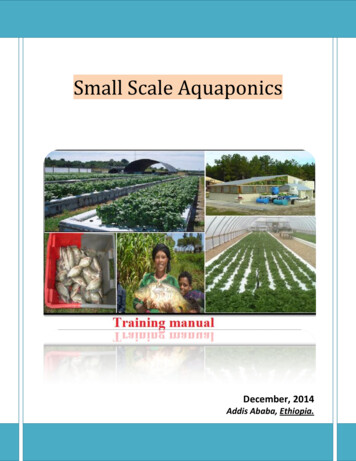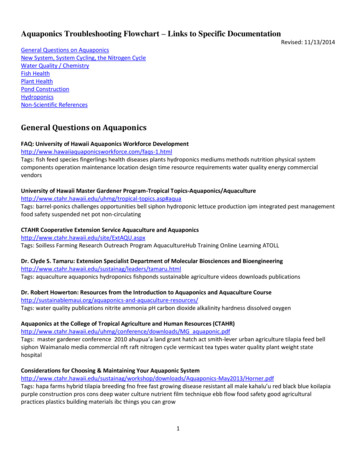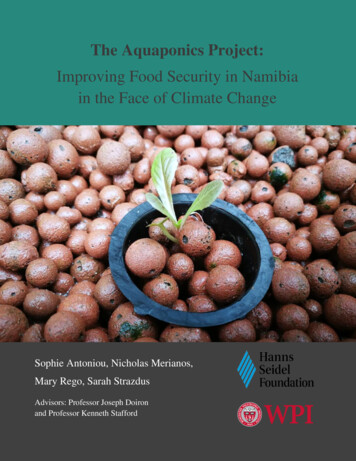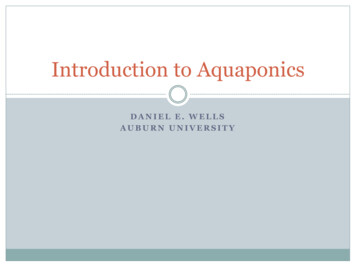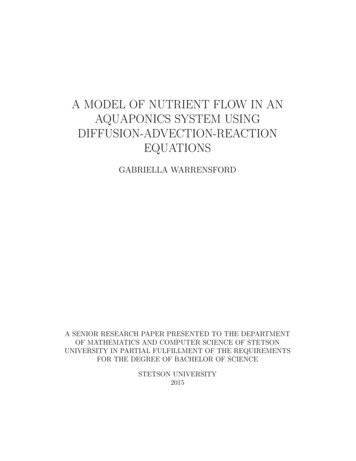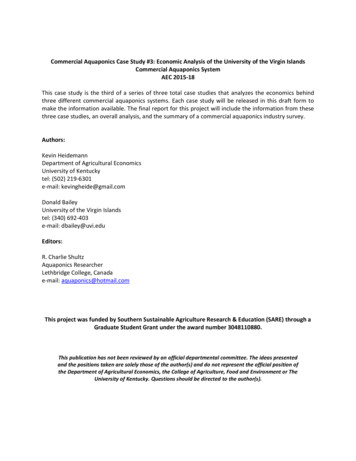
Transcription
Commercial Aquaponics Case Study #3: Economic Analysis of the University of the Virgin IslandsCommercial Aquaponics SystemAEC 2015-18This case study is the third of a series of three total case studies that analyzes the economics behindthree different commercial aquaponics systems. Each case study will be released in this draft form tomake the information available. The final report for this project will include the information from thesethree case studies, an overall analysis, and the summary of a commercial aquaponics industry survey.Authors:Kevin HeidemannDepartment of Agricultural EconomicsUniversity of Kentuckytel: (502) 219-6301e-mail: kevingheide@gmail.comDonald BaileyUniversity of the Virgin Islandstel: (340) 692-403e-mail: dbailey@uvi.eduEditors:R. Charlie ShultzAquaponics ResearcherLethbridge College, Canadae-mail: aquaponics@hotmail.comThis project was funded by Southern Sustainable Agriculture Research & Education (SARE) through aGraduate Student Grant under the award number 3048110880.This publication has not been reviewed by an official departmental committee. The ideas presentedand the positions taken are solely those of the author(s) and do not represent the official position ofthe Department of Agricultural Economics, the College of Agriculture, Food and Environment or TheUniversity of Kentucky. Questions should be directed to the author(s).
Introduction to the UVI Agricultural Experiment Station & Background InfoThe University of the Virgin Islands’ Agricultural Experiment Station is located in beautiful St. Croix of theU.S. Virgin Islands. This is where the world renowned commercial-scale aquaponics system developed bythe University of the Virgin Islands remains. Years of information and data have been collected whileoperating this system, which was used as the basis for this updated economic analysis of the original UVIcommercial aquaponics system.UVI Aquaponic System ConfigurationThe Deep Water Culture system at UVI is one that has evolved from decades of research. What began asa small system with barrels has evolved into a commercial production system that is adaptable andreplicable. It consists of four fish rearing tanks, two clarifiers, four net filter tanks, one degassing tank,six hydroponic beds, a sump, and a base addition tank. However, UVI has conducted research thatproves swirl separators can replace clarifiers in their system. Therefore, this study will assume that swirlseparators will replace clarifiers in the UVI system. The system configuration and tank dimensions areillustrated in Figure 1 and Figure 2 below.Figure 1: UVI Aquaponic System ConfigurationFish Rearing TankEffluent LineDegassing TankBase AdditionHydroponic bedsSumpClarifier/Swirl SeparatorNet Filter TankReturn LineFigure 2: Tank Dimensions & SummaryTankDiameter HeightRearing tanks10 ft4 ftSump4 ft3 ftBase addition tank2 ft3 ftSwirl Separators4 ft77 inTankFilter tanksDegassing tankHydroponic tanksLength6 ft6 ft100 ftWater Volume2,060 gal160 gal50 gal493 galWidth2.5 ft2.5 ft4 ftTotal system water volume: 29,000 gallonsTotal hydroponic plant growing area: 2,300 ft 2Flow rate: 100 GPMDepth2 ft2 ft16 inCone DepthN/AN/AN/AN/ASlopeN/AN/AN/AN/AWater Volume185 gal185 gal3,000 galWater Pump: ½ hpBlower: 1½ hp (fish) 2 hp (plants)Total Land Area: 1/8th AcreThe UVI aquaponic system only requires one eighth of an acre of land and it can contain as much as29,000 gallons of water. Water first flows from fish rearing tanks to the swirl separators. Water exits theswirl separators, flows through the net filter tanks, and then combines in the degassing tank. From thedegassing tank, water flows out to three of the hydroponic beds. Once water flows through these1
hydroponic beds, it enters the other hydroponic bed it is paired with, and then finally flows by gravityback to the sump. Water from the sump is ultimately pumped by a ½ hp water pump back into the fishrearing tanks, and then the water cycle continues.Aquaponic System ConstructionThe aquaculture component of the UVI system requires four fish rearing tanks, two swirl separators,four net tanks, one degassing tank, one sump, and one base addition tank. The dimensions, prices, andother information about these components of the UVI System can be found in Table 1.Table 1: UVI Aquaponic System TanksQuantitySizeItem4' high x10' diametercircular tankPurposeSupplierfish production tank Red Ewald FCT-2350 2350 galhttp://www.redewald.com/426'5" high x 4' diameter swirl separatorcylindrical swirlseparator6' long x 2.5' wide xrectangular tank2.5' highswirl separatorsolids removal6' long x 2.5' wide x2.5' highrectangular tankdegassing tank4' high x 4' diametercircular tanksumpnet tank for finesolids removal4111.5' high x 2' diameter circular tankbase addition1ModificationInfluent water Efluent water Unit Price Total Price4" PVC female adapter coupling asdrain in center bottom. Coupling isfiberglassed to outside tank bottomwith threaded end flush to insidebottom of tank.W. Lim Wave-48 Vortex Body andCover http://wlimproducts.com/vortexfilter.htmRed Ewald FRT-28 280 gallonsinstall PVC sheet as baffle in centerto divide tank into 2 chambers. Cut6" opening in one end of baffle forwater flow between tanks. Eachsection has 3" drain on bottom forsludge removal.Red Ewald FRT-28 280 gallonscut 6" holes in bottom and installstand pipe connecting to hydroponictank.Red Ewald FCT-235 235 galincoming pipe from hydroponic tankand outgoing pipe to pump/fishproduction tanks.Red EwaldFCT-30incoming pipe from pump/rearingtank supply line and outgoing pipe tosumpsumpcenter drain toclarifier - 4" pipefish tanks (2 tankssupply water to 1swirl separator)clarifierone pipeconnecting to nettank - 4" pipedegassing tank 4" diameter pipenet tankhydroponic tanks 6" pipehydroponic tankfish tank - 3" pipepump sidestreamsump 2,155.00 8,620.00 1,000.00 2,000.00 805.00 3,220.00 805.00 805.00 415.00 415.00 110.00 110.00Total 15,170.00The hydroponic component of the UVI system requires six hydroponic raceway-style growing beds. Eachhydroponic bed is 4 ft wide by 100 ft long. The walls of these raceways are poured concrete walls thatare covered by a low density polyethylene (LDPE) liner. Once filled with water, each raceway needs 12Styrofoam rafts that are 4 ft wide by 8 ft long for growing horticultural products. The dimensions, prices,and other information about these components of the UVI System can be found in the Table 2.Table 2: Hydroponic Raceway, Liner, and t water Efluent water Price Each4' wide x 100' long x 16" poured concrete 6" hydroponic line with 9' x 106' P2000 LDPE 23 mil. Fit degassing tankhighwall 5.2 cubic yds. tankwith 6" flange between tanks and to@ 150/ydsump.12' x 750' LDPE linerInland Plastics Ltd.Hydroponic tankliner1.5" x 4' x 8' Styrofoam Dow Chemical Co.square edge ExtrudedHydroponic raftPolystyrene InsulationShipping 1500 total allocated across above itemssump - 6" pipeTotal 1,000.00 6,889.15 1,890.00 2,170.08 31.00 2,562.76Total 11,622.00The UVI aquaponic system requires two air blowers for aeration and a single water pump for watercirculation. The water pump is the only pump required for water circulation throughout the systembecause the rest of the system utilizes gravity. This water pump simply lifts water from the sump intothe fish rearing tanks. The two air blowers circulate oxygen throughout the fish rearing tanks andhydroponic beds separately. The two blowers send air through heat diffusers and then through airhoses, which ultimately deliver oxygen into the system using submerged air stones. One of the airblowers circulates air throughout the fish rearing tanks, while the other blower circulates air throughoutthe hydroponic beds, providing oxygen for the fish and plants. Air stones are scattered throughout thefish rearing tanks and hydroponic beds in order to maintain proper oxygen levels throughout the entiresystem. Table 3 displays information about the blowers and the water pump.2
Table 3: Air Blower and Water PumpQuantity Size1 1.5 HP1 2 HP1 .5 HPItemItem codeAir Blower Sweetwater 1 PhaseAir Blower Sweetwater 3 PhaseCirculating Pump Grundfos 3 Phase UMC 80-80 or similarUnit price Total Cost 739.00 739.00 797.00 797.00 1,268.10 1,268.10Total 2,804.10Many other parts and materials are required for the construction of this system, including many PVCpipes and parts. All of these parts and materials have different uses and purposes. Tables 4 and 5 list allof the other miscellaneous parts that are needed for constructing this aquaponic system, as well asother specific information such as estimated cost, sizes and specifications, uses, and item code numbers.These prices have all been updated, as of 2014, and are estimated as accurately as possible by findingactual price points from manufacturers and distributors that UVI has used.In total, it is expected that those seeking to replicate this system will need to allocate about 1,300towards PVC parts alone. The breakdown of these parts and prices can be seen in the table below. Theseprices can vary depending on factors such as where you purchase materials, the quality of the materials,and the size of the pipes and parts. PVC parts can easily more than double in cost when using 6” asopposed to 4” PVC parts. For example, the above 6” 90º elbow costs 24.81 whereas a 4” 90º elbow onlycosts 7.80; which is more than 3 times the cost.However, it is commonly believed that having larger sized pipes prevents maintenance issues such asclogged pipes. There are many tradeoffs and difficult decisions that must be made when building thesesystems. Although you may save a lot of money buying 3” pipes for the entire system, it may end upbeing a poor decision in the long run. It is very important to carefully consider all implications in boththe long run and the short term when making key decisions such as purchasing materials.Table 4: PVC Parts with UPC & Estimated "4"4"4"4"4"3/4" MPT3/4"3/4"3" x 2"3"3"3"3"3"2" x 1"2" x 1"3Itemcappipe flange SCH 80 solid type FIPT90º elbowTflexible coupling (fernco)capmale couplingfemale coupling45º elbow coupling90º elbow couplingfloat valvefemale adapterwater meterreducer bushingcapcoupling4 way cross90º elbowTreducer bushing spig x fiptreducer bushing spig x socItem code447060851060 (28165 406030401030438249437249Unit price 10.24 21.32 24.81 34.19 12.07 4.28 3.71 3.88 10.16 7.80 26.45 0.25 69.93 1.87 1.88 2.17 7.96 4.36 5.62 1.11 0.79Total Cost 20.48 255.84 446.58 68.38 36.21 8.56 14.84 15.52 40.64 124.80 26.45 0.75 69.93 1.87 7.52 8.68 7.96 47.96 39.34 4.44 4.74
122421172644482"2"2"2"2"2"2"1"1"1"1"1"1"capmale adapterfemale adapter45º elbow90º elbowTTmale adapterfemale adapterpoly plugT poly hose nipple90º elbow poly hose nipplemale threaded poly hose adapter 6010435010*114-C*107-C*105-C*103-CTotal 70 0.55 1.36 1.38 5.64 24.99 3.07 9.10 0.64 1.74 7.40 7.08 7.16 5.60 1,327.20It is estimated that the other parts and materials required to build the UVI system will cost a total ofapproximately 7,500. The breakdown of these parts and prices can be viewed in the Table 5. Again,those seeking to replicate this system may experience varying costs for materials. There are manyfactors that will ultimately determine what price points will be experienced. The cost of these materialscan add up quickly so it is important to try to find ways to reduce the cost of accessing these materials.Table 5: Other Parts & Materials with UPC & Estimated CostQuantitySize43"12"12"42"725ft. 1"23"26"25 gallon22"414' x 100'81" x 2" x 7'164" x 4"8yards 1000 micron10ft. 3/4"3sheets 3/8" x 4' x 8'502" x #81766" x 1.5"881/4" x 3/8"43/8" i.d.1503" x 1"1501/4" NPT x 1/4" barb61/4" i.d.6tube8gallon10101050101organic vapor31"148'x30'148'x47'1206"4ItemItem codeUnit priceball valvesF01300S to regulate flow to rearing tanksball valvesupply water to base addition tank4 way cross420020fish air distribution systemball valvefish air distribution systempoly tubefish air distribution systemtoilet flangesludge collecting and net tank draincap448060sludge collecting and net tank drainbucketsludge collection from clarifiersball valvesludge collection from clarifiersorchard nettingsolids trapceder wood slatsfry screenflat angle bracesfry screennylon net materialfry screenplastic mesh screen (vexar)screening pipesPVC sheetcut from PVC sheet - to connect hydroponic pipe to linerstainless steel screwsto attach donut to pipe flangeairstonesAS15Laquaculture airstonesnipples62008vinyl hoseTV60airstonesAS5Lhydroponic airstonesnipples62006vinyl hoseTV40siliconefiberglass resin and hardnerfiberglass matpaper buckets -disposablepaint brushes - disposablelatex gloves - disposabledust mask - disposablevapor maskball valve (slip x slip)hydroponic air distributionQuonsset greenhouse100% shade clothPVC pipeUnitprice 45.87 12.04 6.02 12.04 0.24 5.00 10.24 5.00 12.04 62.10 5.00 1.00 18.47 4.75 40.00 0.50 6.20 0.30 18.45 2.97 0.30 25.27 5.00 20.00 10.00 1.00 1.00 0.50 2.00 25.00 3.20 2,000.00 500.00 4.00TotalCost 183.48 12.04 6.02 48.16 175.76 10.00 20.48 10.00 24.08 248.40 40.00 16.00 147.76 47.50 120.00 25.00 1,091.20 26.40 73.80 445.50 45.00 151.62 30.00 160.00 100.00 10.00 10.00 25.00 20.00 25.00 9.60 2,000.00 500.00 480.00
80100120104"3"2"1"PVC pipePVC pipePVC pipePVC pipe 4.00 4.00 4.00 4.00Total 320.00 400.00 480.00 40.00 7,577.80Table 6 explains the purpose of all the aforementioned parts and materials. As you can see, each itemhas a very specific purpose for the UVI system.Table 6: Purpose of Parts & Materials Needed for Assembly of UVI Aquaponic SystemQuantity441244262339963211014113221448114125 feet444251442224422Size4"4"4"4"4"4" x 6"6" x 18"4" x 6"6"6"6"6"6"6"6"3"3"3"3"3"3" x 2"2"2"2"2"2" x 1"2"2"2"2"2"1"1"1"1"3"3"3"3"3"6"4"5 gallon2"2"2"2" x 1"5Itemmale couplingfemale coupling90º elbow coupling45º elbow coupling90º elbow couplingpipepipepipeflexable coupling (fernco)pipe flange90º elbowpipe flange90º elbow90º elbowTT90º elbow4 way crossball valvesTreducer bushing90º elbowmale adapterfemale adapterball valveslip x FNPTT90º elbow4 way crosscapball valvepoly tubemale threaded poly hose adapter nipple90º elbow poly hose nippleT poly hose nippletoilet flangeT90º elbowcouplingcapcapcapbucket90º elbow45º elbowball valvereducer bushingItem 6020417020437249Purposeadapt for screen sock in rearing tank bottomfiberglass to bottom of each rearing tankconnect rearing tanks to swirl filterinside clarifier, drains to net tankregulate water level in swirl filter/direct water down in net tankconnect swirl filter to first net tankconnect 2 net tanksconnect net tank to degassing tankregulate water level in degassing tankto connect degassing discharge pipe and supportconnect degassing tank to hydroponic tankto connect hydroponic pipe to linerconnect hydroponic tanks togetherconnect hydroponic tank to sumpconnect hydroponic tank to sumpto connect pump to rearing tanksto connect pump to rearing tanksto connect pump to rearing tanksto regulate flow to rearing tankssupply water to base addition tanksupply water to base addition tanksupply water to base addition tanksupply water to base addition tanksupply water to base addition tanksupply water to base addition tankfish air distribution systemfish air distribution systemfish air distribution systemfish air distribution systemfish air distribution systemfish air distribution systemfish air distribution systemfish air distribution systemfish air distribution systemfish air distribution systemsludge collecting and net tank drainsludge collecting and net tank drainsludge collecting and net tank drainsludge collecting and net tank drainsludge collecting and net tank drainsludge collecting and net tank drainsludge collection from swirl filterssludge collection from swirl filterssludge collection from swirl filterssludge collection from swirl filterssludge collection from swirl filters
2263444443114 rolls488 yards10 ft6885088500 feet1121126811"1"2"2"2" x 1"1"1"1"1"3/4"3/4" MPT3/4"14' x 100'1" x 2" x 7'4" x 4"1000 micron3/4"12" o.d. x 6" i.d.1/4 NPT x 1/4 barb2" x #86" x 1.5"1"1/4 NPT x 1/4 barb3" x 1"tubegallonorganic vapormale adapterfemale adapter90º elbowTreducer bushingfemale adapterball valve (slip x slip)male poly adapterpoly plugfemale adapterfloat valvewater meterorchard nettingceder wood slatsflat angle bracesnylon net materialplastic mesh screen (vexar)PVC donutsmale tubing adapterstainless steel screwsairstonespoly hosemale tubing adapterairstonessiliconefiberglass resin and hardnerfiberglass matpaper buckets -disposablepaint brushes - disposablelatex gloves - disposabledust mask - disposablevapor 435007*R7003*FM26200662006sludge collection from swirl filterssludge collection from swirl filtershydroponic air distributionhydroponic air distributionhydroponic air distributionhydroponic air distributionhydroponic air distributionhydroponic air distributionhydroponic air distributionfresh water supply to systemfresh water supply to systemmeasure water additions to systemsolids trapfry screenfry screenfry screenscreening pipescut from PVC sheet - to connect hydroponic pipe to linernipple adapter for vinyl hoseto attach donut to pipe flangeaquaculture airstoneshydroponic tank air supplyhydroponic nippleshydroponic airstonesAquaponic System Construction Materials CostsAssuming the proprietor would perform all system construction activities, it should cost about 40,500to purchase the materials to build a replica of the UVI aquaponics system (Table 7). Construction costscan add up quickly when building these systems, especially when it is required to hire contractors oroutside labor. The proprietor would need to have experience with digging, plumbing, electrical wiring,general construction, and much more to be able to do this on their own. Many individuals would needto hire contractors, electricians, surveyors, or other professional services to complete construction. Thiswould certainly impact the cost of constructing the UVI system. However, producers building this systemwithin the Continental United States would also experience lower costs for equipment, materials, andsupplies. This is because shipping is a significant cost for everything from tanks to feed when youoperate in the Virgin Islands. Even water and electricity are much more expensive in St. Croix than wouldbe encountered stateside.Table 7: Construction Materials CostsItemRearing tanksSwirl SeparatorsNet tanksDegassing tanksBase addition tankSumpCirculating Pump6Quantity4241111 New cost 10 New cost 68.10Years of Life2020202020205 Annual Depreciation431.00100.00161.0040.255.5020.75253.62
Air Blower (1.5 HP)Hydroponic Tank WallLinerRaftsAir Blower (2 HP)EquipmentPVC PartsOther Parts16 207,577.80 207,577.8040,520.101010101010101010 ponic System Variable CostsTable 8 explains the variable costs associated with running the UVI system after the first year. As youcan see below, variable costs typically amount to about 67,000 on an annual basis for the UVI system.Variable costs are 4,146 lower in the first year since there is no production happening during theconstruction and system acclimation processes. During these phases, and for some time after, fish feedand plant production costs are low. The variable costs associated with growing lettuce from seed in thesystem are relatively low compared to the variable costs associated with raising fish to market size. Infact, the variable costs associated with growing lettuce are only about 10% of the variable costsassociated with raising fish. Labor is also clearly a very significant contributor to total variable cost; laboraccounts for over 69% of total variable cost in year one, and 65% in subsequent years. Labor figures arebased on employees working 30 hours per week 52 weeks out of the year. It is recommended by DonaldBailey, and others who have worked with the system at UVI, to run the UVI aquaponic system with just 2employees working 30 hours per week. This labor is reflected under other variable costs in Table 8below.Table 8: Variable costs for the operation of the UVI Aquaponic SystemFish Variable tricalUniteakgbagCost/Unit 0.30 0.96 9.61kgkgkwh Lettuce Variable ment (Knives)Other Variable CostManager / OperatorHired Labor7Quantity5,2208,503375Total Cost 1,566.00 8,175.00 3,603.751.300.120.5418218214,235 236.60 21.84 7,686.90 21,290.09UniteaCost/Unit 0.01Quantity44,928Total Cost 584.38kgbagskwhsystem 29.0016.000.1010.001729,1255 493.00 32.00 912.50 50.00 2,071.88Cost/Unit 20.00 8.00Quantity1,5601,560Total Cost 31,200.00 12,480.00 43,680.00Total Variable Cost 67,041.97UnitHourlyHourly
Aquaponic System RevenueThings like construction and system acclimation, which is essentially the process of the system buildingup nutrients, take time in the first year of operating the UVI system. This is why production levels will belower in the first year. Certain things such as lettuce can only be produced in cooler weather months inthis tropical climate, which means production is seasonally limited for certain items.During year 1, it should take about 3 months from breaking ground until the first harvest of produce ispossible. It is possible to harvest about 37 cases of lettuce per week for 16 weeks out of the year in St.Croix; other weeks are typically too warm for lettuce harvests. This is because the water temperaturebecomes too high during this time of year, which can last for up to 36 weeks out of the year. During thistime, basil production typically replaces lettuce production. It is possible to produce a total of 3,000kilograms of basil per year, based on past production figures experienced at UVI. Finally, tilapia can beharvested only about 4 or 5 times the first year, and UVI has experienced an average of about 497kilograms of tilapia per harvest. This amounts to a total annual production of over 2,100 kilograms oftilapia during the first year (Table 9).Table 9: Year 1 /Unit 20.0026.465.51QuantityTotal Cost5923,0002,162 11,840.00 79,380.00 11,917.75 103,137.75Future harvest amounts of tilapia are essentially doubled moving into the future. During the first year ofproduction, tilapia can likely only be harvested about 4 to 5 times (Table 10). The UVI system hashistorically experienced an average of 8.7 tilapia harvests per year. Based on this figure, it is estimatedthat this system can produce an average of 4,324 kilograms of tilapia per year. However, this figure isbased on stocking 600 fish per tank. Increasing tilapia stocking density could increase revenue, but theincrease in feed and other expenses must be taken into account when making a stocking densitydecision. Lettuce can only be produced during the cooler months so revenue will likely remain the same.Basil comes in many different varieties, and many varieties can grow year round on St. Croix, whichmeans basil revenue will likely have little variation from year to year.Table 10: Subsequent /Unit 20.0026.465.51QuantityTotal Cost5923,0004,324 11,840.00 79,380.00 23,835.50 115,055.50All of these revenue figures are highly dependent upon price. Where the UVI station is located, in St.Croix, many things can command higher prices. Food can especially command higher prices herecompared to many other places. Much of the food eaten on the island is imported, which makes it moreexpensive. Furthermore, there is limited agricultural production on the island. Therefore, locally grownfood can command a fairly significant price premium. This is especially true when selling to upscalerestaurants and hotels that are fairly abundant on the Island near tourist destinations. The prices used inthis analysis are based on price points experienced by UVI when selling their products on the island.8
Aquaponic Pro Forma Income StatementsThe pro forma income statements in Table 11 represent what producers will likely experience in the first5 years of running the UVI aquaponic system. As you can see, it is possible for producers to experience aslight loss in the first year of production. However, it must be kept in mind that these estimates includewages for a manager and one additional employee. After the first year of production, it is likely thatproducers could experience a net income of over 47,700 annually.Table 11: Pro Forma Income StatementsItemYear 1Year 2Year 3Year 4Year 5Total Value Total Value Total Value Total Value Total ValueIncomeLettuceBasilTilapia 11,840.00 79,380.00 11,917.75 11,840.00 79,380.00 23,835.50 11,840.00 79,380.00 23,835.50 11,840.00 79,380.00 23,835.50 11,840.00 79,380.00 23,835.50Total Income 103,137.75 115,055.50 115,055.50 115,055.50 115,055.50Land / Rent 300.00System Construction 40,520.10 300.00- 300.00- 300.00- 300.00-Total Fixed Cost 40,820.10 300.00 300.00 300.00 300.00Fixed CostVariable CostFish Variable CostFingerlingsFeed 1,566.00 3,533.37Shipping 3,603.75 1,566.00 8,175.00 3,603.75 1,566.00 8,175.00 3,603.75 1,566.00 8,175.00 3,603.75 1,566.00 8,175.00 3,603.75 236.60 21.84 7,686.90 496.00 17,144.46 236.60 21.84 7,686.90 21,290.09 236.60 21.84 7,686.90 21,290.09 236.60 21.84 7,686.90 21,290.09 236.60 21.84 7,686.90 Equipment (Knives) 493.00 32.00 912.50 50.00 2,071.88 493.00 32.00 912.50 50.00 2,071.88 493.00 32.00 912.50 50.00 2,071.88 493.00 32.00 912.50 50.00 2,071.88 493.00 32.00 912.50 50.00 2,071.88Manager / OperatorHired Labor 31,200.00 12,480.00 43,680.00 31,200.00 12,480.00 43,680.00 31,200.00 12,480.00 43,680.00 31,200.00 12,480.00 43,680.00 31,200.00 12,480.00 43,680.00Total Variable Cost 62,896.35 67,041.97 67,041.97 67,041.97 67,041.97(578.70) 47,713.53 47,713.53 47,713.53 tuce Variable Cost584.38584.38584.38584.38584.38Other Variable CostNet Income The above information was used to calculate the Net Present Value (NPV) and Internal Rate of Return(IRR) for this operation. NPV is the sum of the present values of cash flows experienced in a project overa period of time. IRR is the rate of return that makes the NPV of cash flows equal to zero. A conservativeapproach was taken towards estimating NPV and IRR for this operation. Typically, NPV is estimated overthe lifetime of a project and includes figures for asset depreciation. However, NPV was estimated forjust 5 years worth of time and it was assumed assets would have no value at the end of the project.9
Therefore, the true NPV and IRR of this project would be higher because the aquaponics system is likelyto still be operational for much longer than 5 years. The NPV of this operation has been estimated toequal 87,797. This assumes a tax rate of 30% on net income and an interest rate of 8%. The IRR for thisoperation was then estimated to be 71.2%. Again, these values are likely to be higher when the entirelifetime of the investment is taken into account.ConsiderationsThere are clearly some assumptions that have to be made in this analysis. In order to be as accurate aspossible, actual price points, production values, and costs experienced by UVI have been used. Allfigures have been updated and estimated as accurately as possible. If you were to replicate this systemin a milder climate within the Continental United States, then you would likely experience lower costsfor materials, supplies, labor, shipping, and utilities. Furthermore, the production values could be higherfor things like lettuce in milder climates. However, start-up costs may be higher in parts of the UnitedStates where there is a need for infrastructure such as a greenhouse with climate control.It would be wise for producers interested in commercial aquaponics to begin with operating a smallscale system for some time before investing in building a commercial system. Individuals interested incommercial aquaponics should attend an educational workshop at the very least. Aquaponic producersneed to perform all the due diligence possible before breaking ground or seeking funds. There havealready been numerous high publicity failures of extravagant aquaponics systems around the world.Some of the failures in aquaponics can be blamed on cash flow issues, which means it is important toperform a cash flow analysis before beginning operations. In order to succeed in aquaponics, it is vital toseek training, use researched and proven system models, conduct research, and have some type ofemergency or contingency fund in place in the event that something goes wrong. Aquaponics, like othermethods of farming, is subject to the forces of nature and operator error so it is important to beprepared for the worst.ConclusionThese figures are meant to be used as a guide for potential commercial aquaponic producers, in order toh
Commercial Aquaponics System . AEC 2015-18 . This case study is the third of a series of three total case studies that analyzes the economics behind three different commercial aquaponics systems. Each case study will be released in this draft form to make the information available. The final

